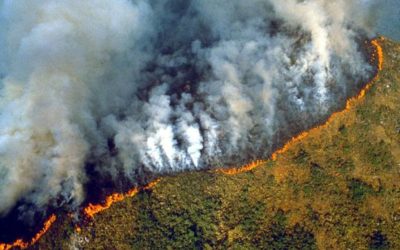by Larry
March, 2018How Permanent is the Amazon?The Amazon basin (a tropical rainforest, river, and jungle system that encompasses 8 Latin American countries, 1100 rivers and tributaries, 2.9 million square miles, and like a heart beating circulatory liquid throughout a body, pumps an average of 32 million gallons of water into the Atlantic Ocean every second) is about the size of the lower 48 United States. We think of it as a stable fixture of the Western hemisphere, yet it is in a state of constant change. Before the rise of the Andes Mountains of Peru, for instance, for a time it emptied into the Pacific. Far more recently, a portion of the current tropical rainforest canopy was not there. Instead, indigenous tribes had a thriving yet sustainable agriculture where now millions of trees are more dominant. Up to around 8 million people are believed to have lived in Amazonia before Columbian times. Using methods that combined turning local wood into charcoal and fertilizing with it plus mulching and adding waste to areas for planting, they are thought to have maintained a balance between the tropical flora and native peoples' food source needs. Besides enjoying nutritional contributions from hundreds of uncultivated Amazonian flora, they raised scores of crops in the region, including sweet potatoes, palm, pineapple, cacao, tobacco, cassava, hot peppers, fruit trees, etc. The early indigenous farming practices are thought to have continued for thousands of years, until diseases brought by Europeans decimated Native American populations, and the jungle took over in many of these formerly inhabited areas, producing there the landscape more familiar to us.
Climate change may now be combining with rapid deforestation to bring about alterations to the Amazon system. Droughts and floods are occurring more often. With the former come more frequent and extensive forest fires. Further, the rainy season is becoming shorter, lengthening the dry season. If the latter gets to be 5-7 months in length, scientists believe the southern Amazon rainforest region will change to savannas. Trees will lack enough annual moisture and so will die. Over much of the southern Amazon basin the rainforests are already at risk due to shrinking wet and lengthening dry seasons. A major shift of the area from tropical rainforest to grassy plains would have ramifications for weather as distant as Texas. These apparent changes may be only the canary in the coal mine, though, an indication of potentially negative things to come, for if the globe is warming significantly the whole Amazon Basin system will likely be affected, with unforeseeable consequences. What happens when a metaphorical beating heart of rainforest water flow is altered or the lungs-like inspiration and expiration of the vast Amazonian flora is no longer influencing the chemistry of the atmosphere? Just as there are vast flows of liquid water now out of the Amazon, so too there are rivers of moisture laden air affecting the climate both near and far. Scientists do not have all the answers yet. There is speculation, however, that with a less healthy Amazon system some of the major ocean currents may be changing and that a more rapid increase in atmospheric carbon dioxide would occur. Along with more rapid melting of the Greenland ice sheet, there is concern that the warming Gulf Stream, vital to keeping northern Europe out of deep freeze Arctic tundra-like conditions, may slow or stop. At the same time, hurricanes, powered by increased evaporation over the oceans, would become more powerful and occur with greater frequency over the same general area. This apparent trend is already causing insurance companies to factor in more severe damage from storms like Harvey, Irma, Jose, and Maria when calculating appropriate premiums to change in coastal areas. In the longer term, the amazing average discharge flows of the Amazon and its tributaries are likely to decline, of course, as that region experiences loss of rainfall. Major changes in rainfall patterns in the Amazon could also have ripple effects on global weather. It will at least be interesting to see how this plays out. |
 Now that too is giving way to deforestation. Huge swaths are being cleared for highways, urban development, valuable hardwoods harvesting, cattle ranching, soy, palm, and other crops, and, to a lesser extent, for subsistence farming.
Now that too is giving way to deforestation. Huge swaths are being cleared for highways, urban development, valuable hardwoods harvesting, cattle ranching, soy, palm, and other crops, and, to a lesser extent, for subsistence farming.